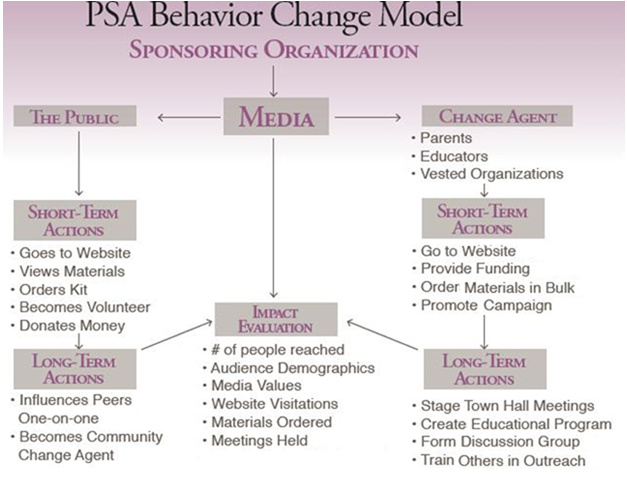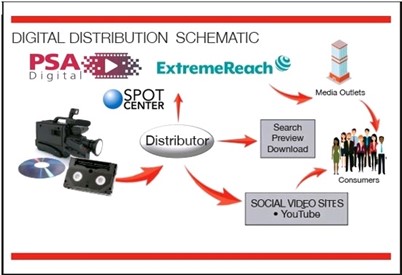When strategically planned and executed, Public Service Advertising campaigns can broaden the reach of your mass communications program, create greater credibility for your organization, and strengthen your brand image. They have also been used to:
- Recruit volunteers for the Armed Forces and Peace Corps
- Encourage people to write for specific information on an issue
- Participate in a special event
- Drive traffic to a website to get additional information
To see case histories of how PSAs have been used to accomplish a variety of objectives, go to: Case Histories. To make it easier to remember the key points for a well-orchestrated effort, we have developed what we call the Five Ps of PSAs: Planning, Promotion, Placement, Performance and Professionalism.
Planning
Unfortunately, many public education campaigns are launched without serious thought or research about campaign objectives. If your budget permits, you should test your message among your target audience with focus groups, often referred to as qualitative research. They will help you sharpen your message, make sure your target audience understands your key points, and keep you from possibly offending your audience. For more information on the basics, go to: Focus Groups.htm. 
If your issue or cause is in the least bit controversial, or if there is any concern how your audience will react, you should definitely survey the media in advance. There are a couple of inexpensive ways to do this: send draft storyboards to the media and ask them for their feedback, or do a brief survey among the media to gauge their reaction to your approach, perhaps sending scripts for your proposed PSA.
After you’ve completed the research phase of your campaign, it’s time to develop your formal, written plan, which ensures you do not omit a key element. You should involve your entire public affairs staff in drafting the plan or anyone who can make a contribution to the ultimate success of the campaign. This graphic shows the key audiences you should include, and appropriate actions for each group. 
Here are some questions you should address in the planning phase of your campaign:
- What are you trying to accomplish via the campaign…create general awareness, drive people to a website, call a toll-free number, raise funds, recruit volunteers?
- How about your primary and secondary target audiences – where do they live, what are their ages, what are their media habits?
- What are your plans to involve other stakeholders such as the media and your own internal audiences such as community partners?
- What are your creative options? Will you produce the campaign internally, or will you hire an external producer? What is the cost vs. benefit for each option?
- What is the campaign scope – is it TV only or will it involve other media?
- What is the one single message you want your audience to remember and what is the call to action?
- What’s your timeline? Are there special events you can tie into to leverage your exposure? When do you plan the launch and how much time before that date to you have to start planning in order to make your deadline?
- Will you distribute the campaign internally or hire an experienced distributor?
Finally, you need to establish a budget and determine who will need to approve all major components of the campaign as it is implemented. By thinking through all your options in advance, it will save from making costly mistakes and guide you through production and implementation.
Promotion
Promotion is critical to the success of a PSA campaign, but it is often overlooked. Here are some tactics that could make a huge difference in the ultimate impact of your PSA:

![]() Cultivate contacts at the TV networks including the big four. ABC, CBS, NBC, and Fox. While they rarely broadcast PSAs on their networks, they may feed your PSA to their affiliate stations. For additional insight on how to deal with TV networks, see the article, “Network Clearance-A Producer’s Checklist” at: Network Clearance.
Cultivate contacts at the TV networks including the big four. ABC, CBS, NBC, and Fox. While they rarely broadcast PSAs on their networks, they may feed your PSA to their affiliate stations. For additional insight on how to deal with TV networks, see the article, “Network Clearance-A Producer’s Checklist” at: Network Clearance.
![]()
There has been an explosion in cable networks, many of which reach people with a particular lifestyle or program interest. Currently there are 200 national cable networks to which we distribute our client PSAs. For one of our clients national networks generated 70 percent of all values for their campaign, so it is particularly important to get network usage. Either have your staff contact them and pitch your PSAs, or have your distributor do it, because it could one of the most successful things you do.
![]() If you’re launching a new campaign that is particularly time sensitive, or has some other compelling argument, consider a pre-campaign alert. These alerts can be blast emails, postcards, or some other creative approach to the media-typically aimed at media gatekeepers. This gives them a heads-up on your new campaign and helps them schedule your PSAs, particularly if they are keyed to a special event.
If you’re launching a new campaign that is particularly time sensitive, or has some other compelling argument, consider a pre-campaign alert. These alerts can be blast emails, postcards, or some other creative approach to the media-typically aimed at media gatekeepers. This gives them a heads-up on your new campaign and helps them schedule your PSAs, particularly if they are keyed to a special event.
Now that all TV PSAs are distributed digitally via online platforms, you must use some type of promotional tactic to let the media know where they can download your PSAs such as the examples shown above.
 Each state has its own broadcaster’s association, which you can also engage in your campaign via pre-campaign alerts or news releases. For a complete list go to: www.askcbi.org/resources/state-broadcasting-associations/
Each state has its own broadcaster’s association, which you can also engage in your campaign via pre-campaign alerts or news releases. For a complete list go to: www.askcbi.org/resources/state-broadcasting-associations/
![]() Try to find a special commemorative event that you can associate with your campaign, as there are special events for just about every cause or concern. If you coordinate your campaign with a special event, – or create one if you can – you could generate substantial publicity.
Try to find a special commemorative event that you can associate with your campaign, as there are special events for just about every cause or concern. If you coordinate your campaign with a special event, – or create one if you can – you could generate substantial publicity. 
 If you have community partners, be sure to include them in your plans and share your creative with them. Your regional or local public affairs staffs can help immeasurably in engaging local media in your campaign. Ask them to tag materials for local use, make local media visits, or give you feedback on local concerns. For ideas on how to do this, go to: Engaging Community Partners.
If you have community partners, be sure to include them in your plans and share your creative with them. Your regional or local public affairs staffs can help immeasurably in engaging local media in your campaign. Ask them to tag materials for local use, make local media visits, or give you feedback on local concerns. For ideas on how to do this, go to: Engaging Community Partners.
Placement
Placement includes all the activities involved in getting your PSA on the air. We use three different download platforms where our client PSAs are posted. One is our own internal site called PSA Digital; a second is the Spot Center created by the National Association of Broadcasters and Extreme Reach, the premier distributor of video assets in the country.
Performance
Collecting data just for the sake of creating a report, is a meaningless exercise. You should, look at the data from various angles, and merchandise it to the fullest extent. For example, make sure your creative team knows what works and what doesn’t. Send evaluation reports to all your stakeholders so they can see the results you are generating. 
There are lots of different reasons for evaluating your campaign:
- It identifies areas of weak usage and provides the basis for correcting these trends before it is too late.
- It provides data to demonstrate you are meeting your organization’s critical mission or Key Performance Indicators.
- You can use evaluation data to calculate cost-benefit ratios (production, distribution and evaluation costs divided into the amount of advertising equivalency value the campaign generated).
- It can help show how you’ve engaged the media in your issue.
- An analysis of phone calls or Web site visits before and after campaign launch can demonstrate the level of public involvement.
- You can use evaluation data to thank the media for all the time and space they devote to your campaign.
- It will help keep your community partners engaged.
- And evaluation can help sustain future funding, because your boss will want to know about your results.
For more specifics on how you can use evaluation data, you may want to read the article: “How You Can Use Evaluation Data to Fine-Tune Your PSA Program” at: Using Evaluation Data.
Professional Competence
In a book published by Advertising Age entitled: Advertising in America, one of the deans of advertising, David Ogilvy, had this to say about advertising in the public interest: “Advocacy advertising is not a job for beginners, but there is a tradition of it within the profession.”

Just like anything else in life, if you want to be really good at your craft, you have to work at it. You need to do the research, and a lot of reading to find out what works and what doesn’t with PSAs, and the only way to know that is to study the literature on the subject.
Like any other mass communications technique, it takes time and effort to learn everything there is to know about producing PSAs that get used. Even experienced advertising agencies and consultants often overlook the basics.
On the other hand, given the data that is available on PSAs, there’s no excuse for creating PSA messages and campaigns that are off target, in the wrong format, or directed to the wrong media people.
When it comes to PSA professional competence, what you don’t know will hurt you. What you don’t know can cause costly mistakes and missed opportunities, which in turn, could be worth millions of dollars of lost exposure for your cause. So, the next time you are ready to launch a major national campaign, think about the 5 P’s of PSAs and make sure you incorporate them into your plans.







Leave A Comment